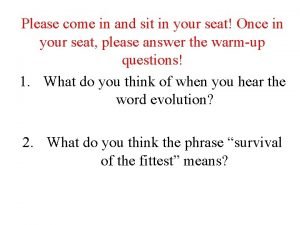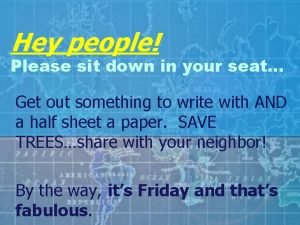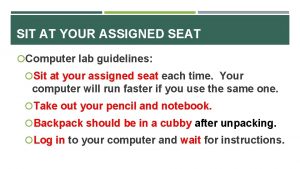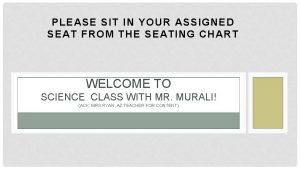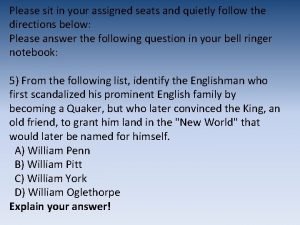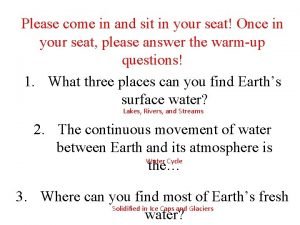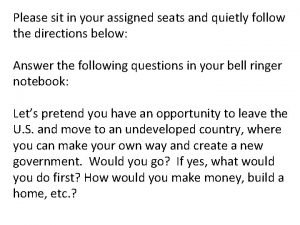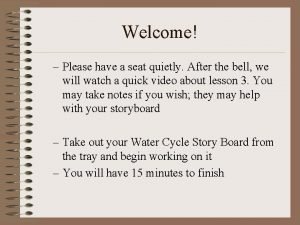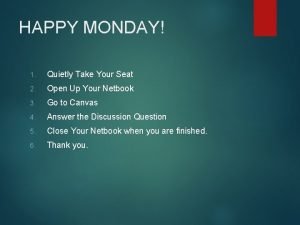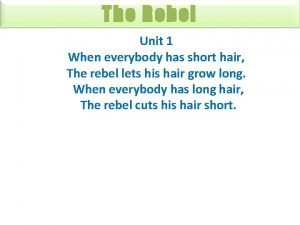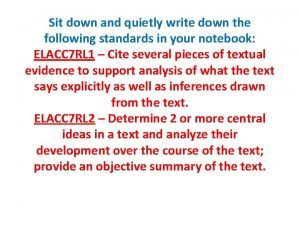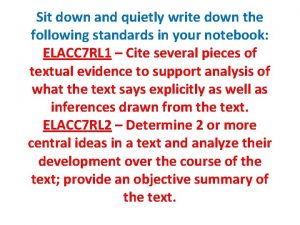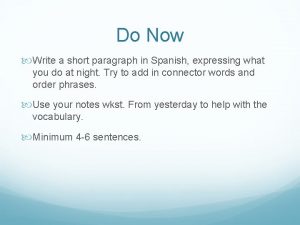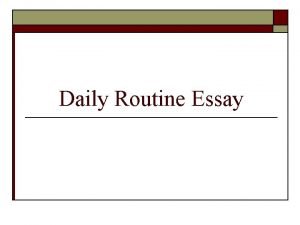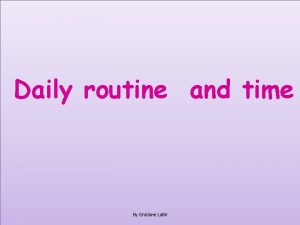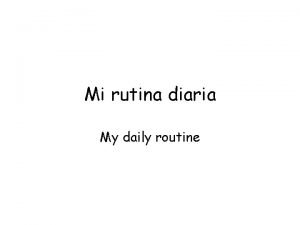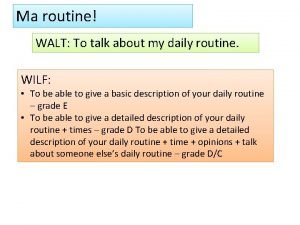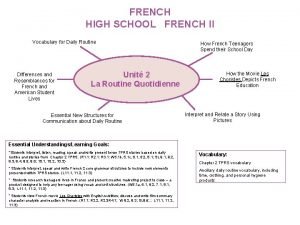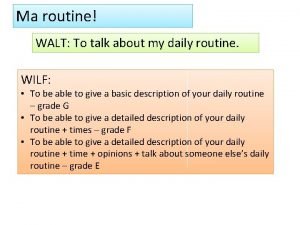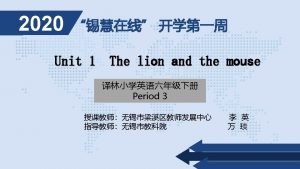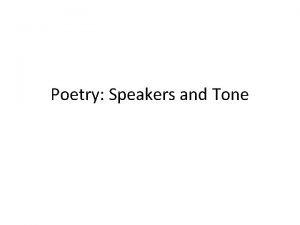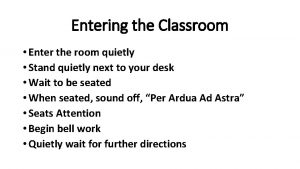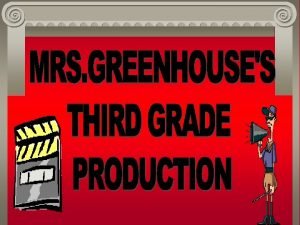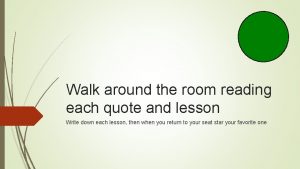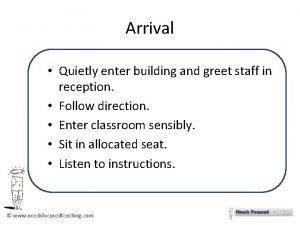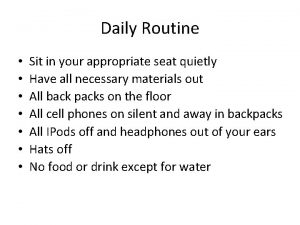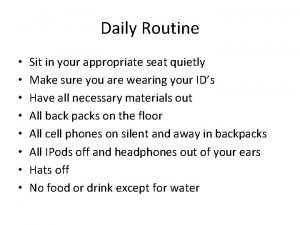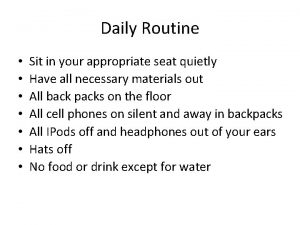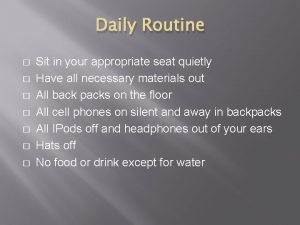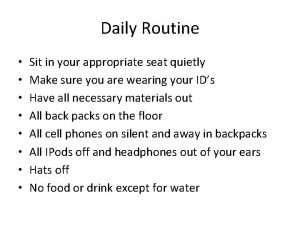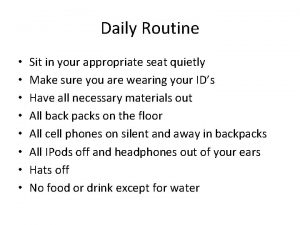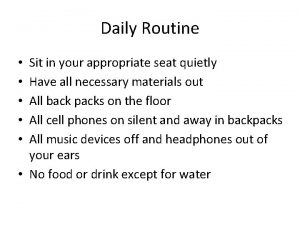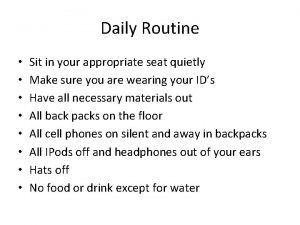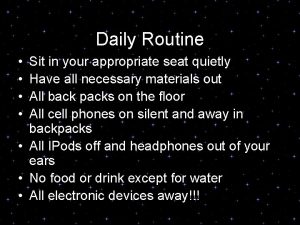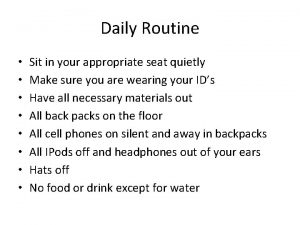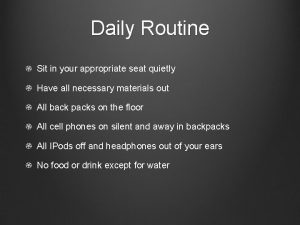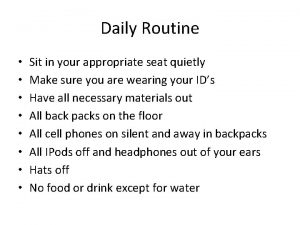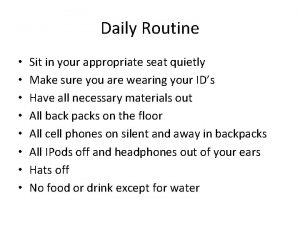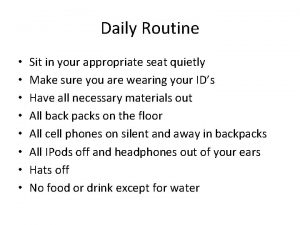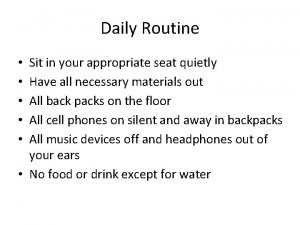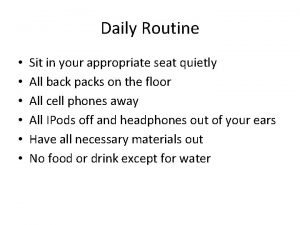Daily Routine Sit in your appropriate seat quietly




































- Slides: 36

Daily Routine • • • Sit in your appropriate seat quietly All back packs on the floor All cell phones away All IPods off and headphones out of your ears Have all necessary materials out No food or drink except for water

Bell Work • How did Kepler help the development of astronomy? • How did Galileo help the development of astronomy?

Announcements • Homework – Phases of the Moon for February • Finish Ellipse Lab Questions

Moon, Sun, Earth Relationships The Solar System: Is Pluto a planet or a dwarf planet?

Today we will • Model Kepler’s First Law of Planetary Motion • Discuss the phases of the Moon and how it cycles through different phases due to Earth’s positioning towards the Sun

Moon – Sun – Earth Movement • Moon moves around the Earth (satellite) and Earth moves rounds the Sun • Two types of movements: Rotation and Revolution • Rotation – Spinning on an axis • Revolution – Motion around an object around another (orbit)

Ellipse Lab • You will be working in groups of four • Rules for Lab: – Phones should remain in your backpacks or at your desk – Use the equipment properly – Remain at your lab station at all times – Work with each other respectfully

Ellipse Lab • Procedure: https: //www. youtube. com/watch? v=Eti. A 5 Aqx 7 i. I • Measurements between foci– 4 different measurements: 2 cm, 5 cm, 7 cm and 9 cm – Everyone in the group must do at least one example – Use pencil • Eccentricity - deviation of a curve or orbit from circularity • Eccentricity = foci distance (d) ÷ major axis length (l)

How did the Moon Form? • Formed 4. 5 billion years ago • The planetesimal Theia impacted Earth • Heat and debris were released from Earth and Theia • Debris joins together and creates orbit around Earth to form Moon

How did the Moon Form?

How did the Moon Form? • https: //www. youtube. com/watch? v=hahp. E 8 b 6 f. DI

Geology Qualities of the Moon • Rocks and minerals similar to Earth’s • Crustal layer consists rugged cratered highland dark, dense lava maria • Highland = granites; thick • Maria = basalt; thin • Has weak moonquakes, but tectonically dead • Heavily crated by meteorite impacts

Daily Routine Sit in your appropriate seat quietly Have all necessary materials out All back packs on the floor All cell phones away All music devices off and headphones out of your ears • No food or drink except for water • • •

Bell Work • What is an ellipse? • Describe how the Moon formed?

Announcements • No Homework

Moon, Sun, Earth Relationships The Solar System: Is Pluto a planet or a dwarf planet?

Today we will • Discuss the phases of the Moon and how it cycles through different phases due to Earth’s positioning towards the Sun

What happened to the Moon after it formed? • https: //www. youtube. com/watch? v=UIKm. SQ qp 8 w. Y

Moon Terminology about Phases • New Moon – no illumination from the Sun on Near Side • Crescent – Moon is less than half illuminated • Quarter – Moon is quarter through cycle, but half illuminated • Gibbous – Moon is more than half illuminated • Full Moon – Moon is fully illuminated

What does Waxing mean? • Waxing means growing • In terms of the Moon, it refers to getting more illumination from the Sun * Mr. Miyagi’s trick to remembering parts of phases of the Moon…Wax on…

What does Waning mean? • Waning means shrinking • In terms of the Moon, it refers to getting less illumination from the Sun * Wax off? Well Mr. Miyagi ment wane off when talking about the Moon…. oh well…

How many times a years does the Moon complete this cycle? • Remember…the Moon completes this cycle in 29. 5 days • Do the Math… 12 to 13 times a year (Blue moon)

Do we see all sides of the Moon? • Nope, we don’t see the dark side of the Moon • Lunar month 29. 5 days • The moon completes one revolution around Earth in 27. 5 days • The moon rotates as the Earth rotates so we only see one side of the moon

Impact Lab • In the same groups as yesterday • You will only perform tests on two objects not three, and you will only need to use one of the graphs • We will have 50 minutes to work on this in class, so be productive • Rules for lab: – Phones should remain in your backpacks or at your desk – Use the equipment properly – Remain at your lab station at all times – Work with each other respectfully

Graphing Data from Impact Lab

Daily Routine Sit in your appropriate seat quietly Have all necessary materials out All back packs on the floor All cell phones away All music devices off and headphones out of your ears • No food or drink except for water • • •

Bell Work • How many days does it take for the moon complete its phase cycle? • What are the phases of the moon?

Announcements • No Homework

Moon, Sun, Earth Relationships The Solar System: Is Pluto a planet or a dwarf planet?

Solar Eclipse vs. Lunar Eclipse • • • Solar Eclipse Moon casts a shadow on Earth Moon passes between Earth and the Sun Total Eclipse – within umbra Partial – within preumbra Happens during New Moons and Full Moons

http: //www. youtube. com/watch? v=_2 01 tt. TSG 30

Solar Eclipse vs. Lunar Eclipse • • • Solar Eclipse Moon casts a shadow on Earth Moon passes between Earth and the Sun Total Eclipse – within umbra Partial – within preumbra Happens during New Moons Lunar Eclipse • Earth casts a shadow on the Moon • Earth passes between Moon and Sun • Happens during Full Moons

http: //www. youtube. com/watch? v=w uh. NZej. He. Bg

Moon’s Effect on Tides • Caused by Moon’s gravitational pull • Spring Tides: higher tides on Earth • Neap Tides: Lower tides on Earth

http: //www. youtube. com/watch? v =n. Xse. TWTZlks

Layers of the Sun, Earth, and Moon • Obtain a textbook • Label the different layers of the Sun, Earth and Moon using the textbook – Earth on pg. 72 – Moon on pg. 557 – Sun on pg. 573 • Write a paragraph (6 -8 sentences) comparing and contrasting the internal structure of the Sun, Earth, and Moon
 Please sit down and your seat belts
Please sit down and your seat belts Hey hey people
Hey hey people Sit in your assigned seat
Sit in your assigned seat Sit in your assigned seat
Sit in your assigned seat Sit in your assigned seat
Sit in your assigned seat Seat and sit
Seat and sit Sit in your assigned seat
Sit in your assigned seat He took his seat quietly
He took his seat quietly Subordinating conjunctions awubis
Subordinating conjunctions awubis Britney spears characters
Britney spears characters When everybody has short hair poem
When everybody has short hair poem Sit down quietly
Sit down quietly Sit down quietly
Sit down quietly Sit ins
Sit ins Short paragraph in spanish
Short paragraph in spanish Daily routine essay
Daily routine essay Daily routine in arabic
Daily routine in arabic Pseudocode for daily routine
Pseudocode for daily routine Rutina diaria me visto
Rutina diaria me visto Ma routine quotidienne essay
Ma routine quotidienne essay Daily routine french vocabulary
Daily routine french vocabulary Daily routine test
Daily routine test Reading daily routine
Reading daily routine Ma journée quotidienne essay
Ma journée quotidienne essay My daily routine in present continuous tense
My daily routine in present continuous tense Have lunch
Have lunch What did you do this morning
What did you do this morning Quietly happy meaning
Quietly happy meaning Modifying adverbs
Modifying adverbs What is speaker in poem
What is speaker in poem Enter the room quietly
Enter the room quietly If they have time at the weekend they will come to see us
If they have time at the weekend they will come to see us Quietly arrayed
Quietly arrayed Enter quietly
Enter quietly Leave quietly
Leave quietly Walk around the room
Walk around the room Enter quietly
Enter quietly
